|
Part 2. |
 |
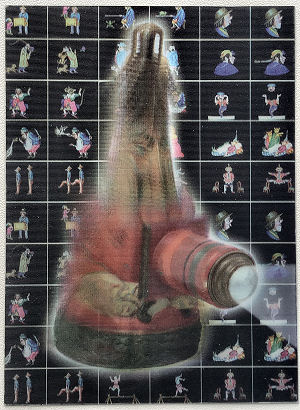 |
Lenticular images. Lenticular postcards and other printed matter are immediately noticeable because of the tangible plastic ribs that cover the image. Those ribs are in fact very fine, side-by-side elongated semi-cylindrical lenses. They can be quite coarse in structure, but also very fine in size. Depending on the angle at which one looks at the printed matter, one sees a different picture. By changing that angle, the images seem to blend into one another. The technique came on the market in the 1940s, when developments in the field of plastics enabled the production of such fine lens grilles. One of the first uses was a badge for Eisenhower's presidential campaign with the slogan "I Like Ike!" along with a photo of the president in lenticular print. This technique is used in three different applications. The most common is where two different images are seen when the print is tilted to and fro. Some copies even show a moving image when tilting, an animation in which multiple shots of a moving object are used. The more shots that have been taken, the smoother the image will be shown. |
|
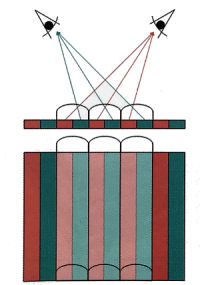 |
Within the scope of this site, the third
application is the most interesting, the one that show an image with depth
effect. So stereo images. The techniques used for this are even more complicated
than with the normal images. The stereo image is composed of two different photo
negatives, which are projected onto photo paper via a grid. Half of the first
negative is projected and after that half of the second negative as well. The
rest is held back by the grid. The resulting photo looks striped. After placing
the lenteculi-foil on the photo, depth is created. It will be clear that assembling the strips of the two photos and also applying the foil with lenticules requires great precision. In the analogue era, this procedure was extremely difficult and therefore expensive. With the arrival of the computer and associated software, it became much cheaper and more accurate, so that it is now being used more often. |
|
|
The prints where two different images are
seen during tilting the print are called Flippos. The possibilities for this are
virtually limitless. They have been and are used in the advertising industry,
such as postcards, pictures of pin-ups with and without clothes, gadgets, key
rings and even on stamps. The Flippo shown here shows alternating two famous magic lanterns made by Aubert-Paris, the 'Tour Eiffel' and the 'Bouddha' when tilting up and down. |
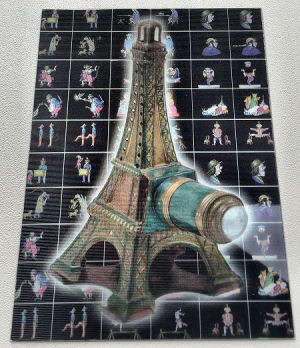 |
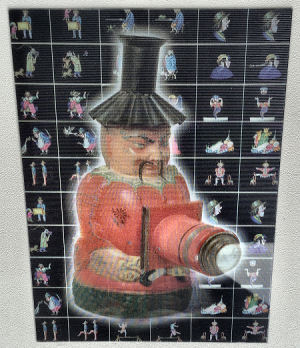 |
|
Lantern slide with a lenticular image The lenticular system is mainly used on picture postcards and other printed matter. It was a great surprise to discover that there is also, at least one, magic lantern slide that uses this system to make the image move. According to the label on the slide, this very special slide was made under the patents of A.S. Spriegel, exclusively for the Genre Transparency Co,. Chicago. Performing, selling or renting outside of U.S. was prohibited. The lantern slide has the American size, approximately 8 x 10 cm.  |
|
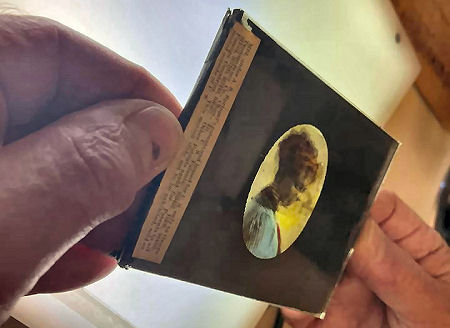 |
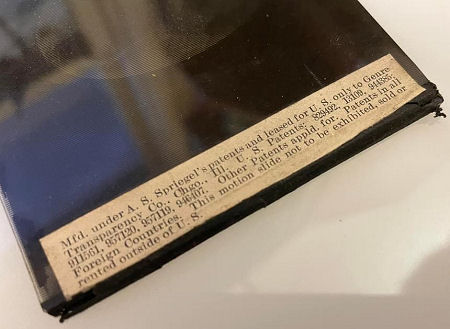 |
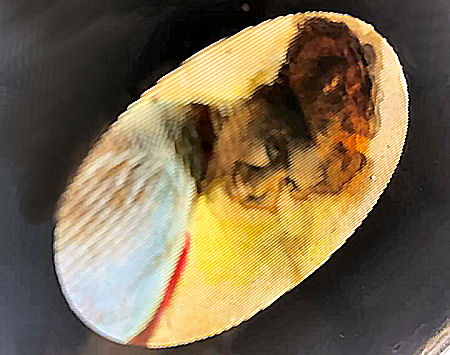 |
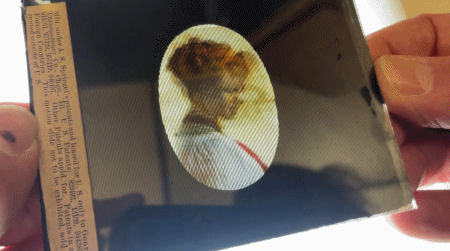 When the lantern slide is wiggled a little, the young woman moves her head to and fro. |
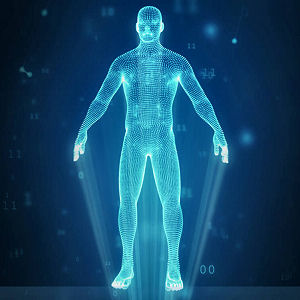 |
Hologram. Holography is a technique of creating a three-dimensional image of an object, using a flat surface in the form of a photographic film or sensor, or an engraved structure. By looking at the image from different angles, the flat image appears to change so that the impression of a spatial, three-dimensional image exists. However, the image does not really exist but is represented by places where light is present and by places where there is less or no light.The result can only be seen from a limited angle. There are different types of holograms that can be used for different purposes. One of those purposes is security, amongst other things credit cards and banknotes. |
Projecting a hologram is reminiscent of
an optical trick to create the illusion of a ghostly
appearance using a magic lantern. This trick was already shown in theatres
around 1870 and was known as Peppers Ghost, because
John Henry Pepper, a London chemistry professor, was the first to succeed in
performing this illusion on the stage.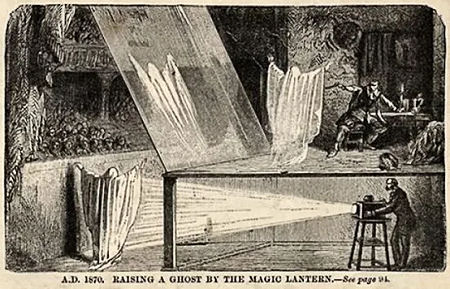 |
How it works: A glass plate, which has been turned at an angle of 45 degrees, has been placed between the stage and the audience. In front of the stage, in a place that is not visible to the audience, stands the person who must appear as a 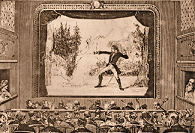 ghost.
This person is illuminated by the bright lamp of a magic
lantern. The audience then sees the reflection of the person
in the glass plate, but because one can see through it, it looks like a ghost on
the stage. This illusion can be reinforced by a player on
stage who cleaves the 'ghost' several times with his sword.
By slowly turning the lamp on or off, the ghost is made to slowly appear or
disappear. ghost.
This person is illuminated by the bright lamp of a magic
lantern. The audience then sees the reflection of the person
in the glass plate, but because one can see through it, it looks like a ghost on
the stage. This illusion can be reinforced by a player on
stage who cleaves the 'ghost' several times with his sword.
By slowly turning the lamp on or off, the ghost is made to slowly appear or
disappear.The trick could of course also be performed with all kinds of objects, but that was a bit less spectacular. |
|
The Pepper's ghost technique is nowadays also used in various
attractions such as the Efteling Spookslot (Dutch amusement park) where it is
used to show four ghosts and a floating ghost violin. |
|
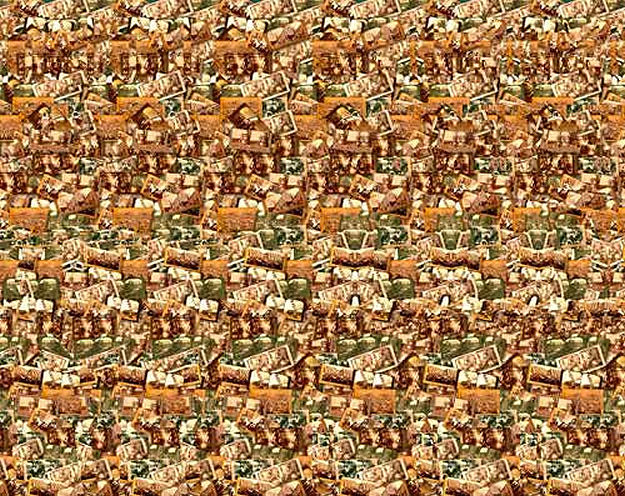 This auto-stereogram comes from the site for Magic Eye Inc., www.magiceye.com. The hidden image has something to do with 3D. |
Auto-stereogram Hidden images |
| Auto-stereograms are 3D
images hidden within another picture. The way to discover and view the 3D images
is simply to stare at the picture until the image appears. Don't focus at the
surface of the picture but try to stare through it, like looking in the
distance. Once you begin to see the hidden image, keep looking at it and it will
become sharper and more clear. Though the official term for this optical illusion is auto-stereogram, we mostly simply speak of stereogram. The advantage of these stereograms is that they can be viewed without any visual aid. |
| |
©1997-2024 'de Luikerwaal' All rights reserved. Last update: 22-02-2024. |
|